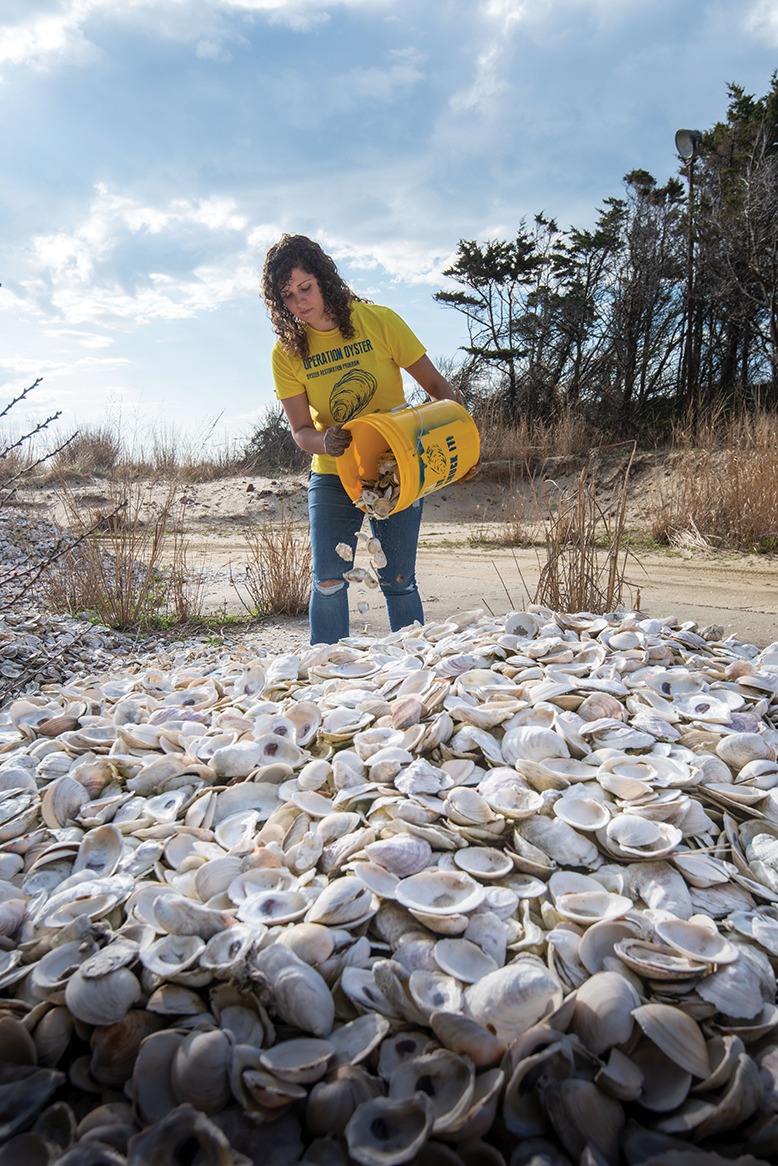
Serena Celestino of the American Littoral Society’s Shuck It, Don’t Chuck It! program deposits shells at Sandy Hook, where they will support new life. Photo by James J. Connolly
Serena Celestino grew up serving customers at Vinnie’s, her family’s venerable Barnegat restaurant. Today, restaurants are her customers. As the new full-time coordinator for the American Littoral Society’s Shuck It, Don’t Chuck It! shell-recycling program, she enlists local restaurants to donate, rather than discard, their used oyster, clam and mussel shells. The shells are collected, cured in the sun, and spread along shorelines in the Navesink and Shrewsbury rivers.
Once plentiful in the two rivers, oysters are no longer harvested there due to poor water quality. However, installing used shells along the shorelines creates habitat for fish, crabs and other invertebrates, as well as vegetation such as native eelgrass, that filters the water. This living shoreline, as it’s called, also prevents erosion by reducing the force of waves, according to Celestino—who, while working at Vinnie’s, earned degrees in ecology evolution, natural-resource management and geological sciences from Rutgers University.
“I grew up in the restaurant business and managed one for seven years,” says Celestino, 27, referring to Vinnie’s Italian Restaurant and Pizzeria, from which she stepped back in March 2021, but continues to help on the administrative side. “People don’t realize how individual every restaurant is and how fast-paced and difficult it is to work in one. Having that understanding allows me to relate with everyone working there.”
Funded by grants from the Marta Heflin Foundation and, most recently, the National Oceanic and Atmospheric Administration (NOAA), Shuck It, Don’t Chuck It! aims to collect at least 10 tons of shells annually from restaurants in towns along or near the rivers, including Navesink, Middletown, Fair Haven, Rumson, Sea Bright, Monmouth Beach, Atlantic Highlands and Red Bank.
Celestino plans to expand the program over the life of the NOAA’s two-year grant to 15 restaurants from its current six: the Bonney Read in Asbury Park (one of NJM‘s top restaurants there); 2nd Jetty Seafood, Eventide Grille and Woody’s Ocean Grille in Sea Bright (which recently made NJM‘s list of best Shore eateries); Navesink Country Club in Middletown; and Nicholas Barrel & Roost in Red Bank.
Her strategy? Face-to-face meetings with the “people who run things,” she says. “I’ll go in person and see who the correct contact is, then get the opportunity to chat, maybe take a look around and help them figure out how it could work for them.”
She explains the benefits of participating: earning a reputation as a steward of local waterways, keeping the shells out of landfills, and saving money on waste disposal. “Some waste disposal goes by weight and some by how quickly a dumpster is filled,” she says. “Either way, removing that shell will make a difference.”
Participating restaurants receive yellow, 5-gallon buckets imprinted with the project’s blue logo. The buckets come with lids and are stackable. “We’ll start them off slowly,” she says. “I’ll ask, ‘Can we give you three buckets and test it out?’”
A pickup schedule is arranged based on the amount of shell produced and the storage space available for the buckets, which each weigh 20 pounds when filled and require refrigeration to avoid odors. “Our goal is to make this as streamlined as possible,” she says. “Whether you need us there every other day or once a week, we’ll accommodate you.”
Celestino, Littoral Society employees or volunteers pick up the shell-filled buckets and drive them to a site near the society’s headquarters on Sandy Hook, where they’re spread outdoors for six months. This curing process rids them of bacteria and any parasites left on the shell.
The cured shells are transported by barge or boat, depending on the amount, to Gunning Island—the project’s first restoration site. The 30-acre island, owned by the borough of Rumson, lies at the mouth of the Shrewsbury.
The project will also feature community drop-off sites where residents can bring their own shells. The first is planned near the Rumson municipal boat ramp and will provide an alternative to trying to get onto Sandy Hook during the height of summer.
Celestino will also be involved in community outreach, recruiting volunteers and promoting the shell-recycling program at festivals, including this September’s Asburyfest and the Red Bank Guinness Oyster Festival.
She’ll cohost lunches for volunteers and the public at restaurants currently or interested in participating in the program. These Lunch & Learns will include a fixed-price menu and speakers discussing shell recycling, the restoration process, or local aquaculture.
By involving restaurants and community residents in Shuck It, Don’t Chuck It!, Celestino believes the project will naturally take hold and grow. In fact, restaurants curious about the project have already reached out to her. “Restaurants know that people are interested in shell recycling and will go to a restaurant because it’s doing something for the community and helping the environment,” she says. “It’s a popular idea, and it’s spreading down the coast.”



